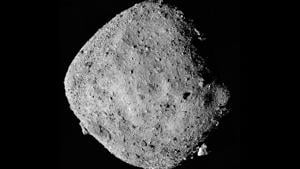
(CNN) — If the near-Earth asteroid Bennu were to collide with Earth in the future, the space rock could cause substantial global damage, even though it’s a fraction of the size of the asteroid that wiped out the dinosaurs, according to new research.
Astronomers estimate that Bennu has a 1 in 2,700 chance of affecting Earth in September 2182, which equates to a 0.037% chance.
The asteroid, which contains the building blocks of life according to recent studies of samples returned to Earth by NASA’s OSIRIS-REx mission, is a medium-size space rock reaching about 1,640 feet (500 meters) in diameter. The asteroid that slammed into Earth 66 million years ago and led to the extinction of dinosaurs was estimated to be about 6.2 miles (10 kilometers) in diameter and marked the last known large asteroid to hit the planet.
Given the small but not impossible chance of Bennu’s potential impact in the future, a research team modeled the effects such a collision would have on our planet, including the global climate and ecosystems across land and the oceans. A study detailing the outcomes published Wednesday in the journal Science Advances.
Medium-size asteroids such as Bennu collide with Earth about every 100,000 to 200,000 years, according to the study.
The researchers found the strike could lead to a global winter that could reduce rainfall and cool the planet among other effects that might persist for years. And it’s possible that early humans may have lived through similar conditions during previous asteroid collisions.
“Our early human ancestors may have experienced some of these medium-sized asteroid strike events before with potential impact on human evolution and even our own genetic makeup,” said lead study author Dr. Lan Dai, a postdoctoral research fellow at the IBS Center for Climate Physics, or ICCP, at Pusan National University in South Korea.
A chain of global consequences
The researchers used climate models and the aid of the Aleph supercomputer at ICCP to run different scenarios for a Bennu-type collision with Earth, largely focusing on the effects of injecting 100 million to 400 million tons into Earth’s atmosphere. The results showed dramatic disruptions in our planet’s atmospheric chemistry and climate within three to four years after the asteroid strike.
At first, the impact would create a powerful crater and cause material to spray up into the air near the strike site. The collision would generate a powerful shock wave and earthquakes, too, Dai said. Large quantities of aerosols and gases released by the impact could ascend into the atmosphere, altering Earth’s climate with lingering effects, she said.
If Bennu were to strike the ocean, it would trigger massive tsunamis and launch large amounts of water vapor into the air. These events could cause a global ozone depletion in the upper atmosphere that could last for years.
“The climate-active aerosols, including dust, soot, and sulfur, could contribute to a multi-year cooling after the impact,” Dai said in an email. “In contrast to aerosol-driven cooling, greenhouse gases such as (carbon dioxide) emissions might cause long-term warming.”
The most intense scenario, which has 400 million tons of dust swirling in Earth’s atmosphere, would lead to a global “impact winter,” or a period of cold temperatures, reduced sunlight and decreased precipitation, Dai said.
Dust particles lofted high into the air would absorb and scatter sunlight, preventing it from reaching Earth’s surface. The lack of sunlight would cause global temperatures to drop rapidly by as much as 7.2 degrees Fahrenheit (4 degrees Celsius). And as global temperatures plummeted, rainfall could drop by as much as 15% because less evaporation would be occurring on the ground, the study findings showed. The ozone layer could also deplete by as much as 32%, according to the study.
And depending on where the strike occurred, the effects could be felt even more severely regionally, the study authors noted.
“Our results show dust particles with atmospheric lifetime of up to 2 years could cause a global ‘impact winter’ for more than 4 years after the impact,” Dai said. “The abrupt impact winter would provide unfavorable climate conditions for plants to grow, leading to an initial 20-30% reduction of photosynthesis in terrestrial and marine ecosystems. This would likely cause massive disruptions in global food security.”
While modern humans haven’t lived through an asteroid strike, Dai compared the environmental effects to other “sun-blocking catastrophes,” such as large volcanic eruptions.
The amount of global cooling estimated in the study is comparable to what occurred when Sumatra’s Mount Toba experienced a super-eruption, considered to be one of the largest in Earth’s history, that likely disrupted the global climate 74,000 years ago.
The research results align well with the studied effects of earlier impacts in Earth’s history, said Nadja Drabon, assistant professor of Earth and planetary sciences at Harvard University.
“Many of those past impacts were substantially larger, with their effects often being more severe and longer-lasting,” Drabon said. “(The) study is particularly interesting, as it shows that even relatively ‘small’ impacts could emit enough dust to severely limit photosynthesis, leading to severe issues in the food chain. We believe similar events happened earlier in Earth’s history, but with even more extreme reductions in primary productivity.”
Drabon was not involved with this study but has authored research about what might have occurred when a massive space rock, estimated to be the size of four Mount Everests, slammed into Earth more than 3.2 billion years ago.
An ocean surprise
The most unexpected result of the study showed unusual behavior by marine plankton. The researchers expected the tiny organisms to reduce rapidly and recover slowly. However, the ocean plankton would likely have already recovered within six months and potentially increase afterward “to levels not even seen under normal climate conditions,” Dai said.
“We were able to track this unexpected response to the iron concentration in the dust,” said study coauthor Axel Timmermann, who is director of the ICCP and a distinguished professor at Pusan National University, in a statement.
Iron is a key nutrient for algae, but in areas such as the Southern Ocean and the eastern tropical Pacific, the mineral is not available in abundance. But if the iron content in Bennu is high and distributed across the ocean, it could trigger unprecedented blooms of algae, in particular the silicate-rich kind called diatoms, for up to three years, according to the study.
The algae blooms would also attract zooplankton, which are small predators that feed on diatoms.
“The simulated excessive phytoplankton and zooplankton blooms might be a blessing for the biosphere and may help alleviate emerging food insecurity related to the longer-lasting reduction in terrestrial productivity,” Dai said. “However, the exclusive diatom blooms may have a harmful effect on ecosystem diversity. For example, diatoms have a competitive advantage over small phytoplankton under iron-rich conditions in the Southern Ocean. The pronounced diatom blooms could prevent the growth of small phytoplankton.”
The positive response from some life-forms, especially simple, single-celled organisms, is something that has been observed in Earth’s past, Drabon said.
Next, the researchers plan to model the responses early humans may have had to asteroid strikes, simulating their life cycles and how they may have searched for food.
“It’s important to recognize that impacts on Earth are inevitable, it’s just a matter of when and how large they will be,” Drabon said. “Everyone knows about the dinosaur-killing impact. However, smaller impacts are far more likely to occur, and thus studying their effects is crucial.”
The-CNN-Wire
™ & © 2025 Cable News Network, Inc., a Warner Bros. Discovery Company. All rights reserved.
#NearEarth #asteroid #Bennu #hit #Earth #years #set #global #impact #winter #study #National












Leave a Reply